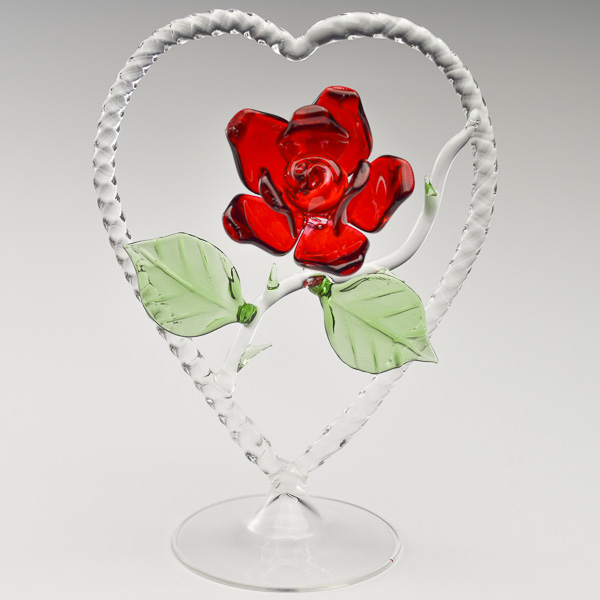
A wide range of techniques are used to produce our products' finishes. In the early days, hobby paints and frosting were the only methods of adding colour to our glass. However, in recent years, the quality and availability of coloured borosilicate has improved, giving us the ability use a wider variety of techniques in both production and post-production.
Raw materials used to make our glass sculptures
Our glass sculptures are produced from high-quality borosilicate rods and tubes, melted by hand in an flame generated by oxygen and and propane. As a 'hard' glass, borosilicate's melting point is approximately 1,600ºC, and as such, our bench glass-blowing torch's flame generates heat in excess of 2,000ºC in order to enable the manipulation of the raw materials.
Once completed, the sculptures are annealed in our glass kiln. Annealing is the process of slowly cooling glass where the items are heated to approximately 600ºC, then cooled slowly. This process relieves the stress created from sculpting the glass at such high temperatures. Items that are subsequently painted, stained, and or have precious metal-oxide stains applied, are then 'fired' in the kiln at various temperatures depending upon the type of finish.

Colouring our glass sculptures

We use a variety of techniques to achieve the finishes you see on our products, and in many cases, they are used in combination. For example, the Pink Stargazer Lilies pictured comprise a clear glass stem, frosted and spray-painted pink petals, hand-detailed red spots. Further, green coloured glass leaves accompany these flowers in a clear vase.
With the exception of items comprising coloured glass, all finishes are applied after items have first been annealed in the kiln. Below you can find further details with photographic examples of all of the finishes we offer, and how we achieve them. To find out more, click the titles to expand/reveal the details.
Our glass finishes and how they look

How the "frosted" effect is achieved on our glass.
To achieve the finish described in our products as, "frosted", the glass is blasted with fine grit. This results in a the item having a white, non-reflective or matte finish. Occasionally, we apply colour to "frosted" items too.

How the "frosted colour" effect is achieved on our glass.
The delicate, muted finish described as "frosted colour" or "frosted/coloured" is achieved in one of two ways. It is either blasted with fine grit, as described in "frosted" and then spay-painted, or it is simply spray-painted with a special matte paint. The crocus pictured is the former.

How we finish items described as "24ct Gold Highlighted"
Our sculptures described as being "highlighted 24ct gold" are hand-painted with an oil suspension of 24ct gold before being fired in the kiln at 600 degrees Celsius. This evaporates the oil, leaving the gold bonded to the glass.

How we achieve the "lustred" effect on our sculptures.
Our sculptures described as being "lustred" are hand-painted with an oil suspension of a range of base and precious metals (gold, silver, platinum & titanium) before being fired in the kiln at 600 degrees Celsius. This evaporates the oil resulting in a metallic coloured sheen, and in some cases, an iridescent finish.

How we achieve the "stained" finish on our sculptures.
Our sculptures described as being "stained" or "lacquered" are either spray-painted or dipped in a lacquer, achieving a high-gloss transparent finish. They are then fired in the kiln.

About our sculptures that use coloured glass.
Our sculptures described as comprising "coloured glass" are made in the same way as our plain glass items. The only difference being, that the raw materials have already been coloured by the manufacturer using metal oxide powders while it is in a molten state. After sculpting the items, they are annealed in the kiln. Coloured glass is often used in combination with clear glass, as pictured.
Bases and stands for our sculptures
Examples of products and their bases
As you can see below, the 'Rose Heart' stands on an attached 'turned' base. Similarly, the Lying Rose rests on its leaf and two points of its stem, whilst the Rocking Horse rests on its rockers.
We affix many of our products to flat bases that are referred to as plinths. You'll find many of our Dragons affixed to plinths of Snowdonia Slate, such as Welsh Heritage Dragons. In addition, many of our wildlife sculptures are mounted on agate slices, mirrors, or cut and polished agate geodes.
The impact of our large Fantasy Dragons and Birds of Prey is enhanced by their bases. These are either naturalistic chunks of slate, simulating crags that occur in the landscape, the warm glow emitted from a salt rock lamp, or the colours of our split, polished agate geodes.







